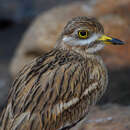Biology
provided by Arkive
Stone curlews hunt at night. Their diet consists of invertebrates such as beetles, woodlice and earthworms, as well as the occasional small mammal or bird, all of which are taken from the soil surface (3). They return to England from the over-wintering grounds in March, and pairs, which may be life-long, return to traditional nesting sites. The nest is a scrape on the ground in which two eggs are laid (2). Eggs and juveniles are cryptically coloured to provide camouflage against the stony substrate. The chicks improve this camouflage by their habit of freezing flattened against the ground when disturbed or threatened (2). If chicks or eggs are lost the pair may produce a second brood (2).
Conservation
provided by Arkive
The stone curlew is a UK Biodiversity Action Plan species, and is targeted by a Species Recovery Programme carried out by English Nature and the RSPB. Under this programme, nests on arable farmland have been located and protected with the help of farmers and landowners. Agri-environment schemes have been used to improve farmland habitat for the stone curlew, for example under the Countryside Stewardship Scheme farmers in the south-west of England are paid to create nesting areas for the species. A number of important stone-curlew areas are designated as Sites of Special Scientific Interest (SSSIs) or National Nature Reserves (NNRs). In addition, Ministry of Defence training areas where stone curlews occur are managed in ways that benefit the species, for example by providing large areas for nesting habitat (3).
Description
provided by Arkive
The specific name Oedicnemus derives from the Greek for 'swollen shinned', these birds are also known as 'thick knees' due to their large heavy looking legs (4); other local names include 'Norfolk plover' and 'Goggle eyes' (2). Stone curlews have streaky sandy- brown plumage that provides excellent camouflage against sandy soils during the day when they are mainly inactive (2). In flight, narrow black and white bars on the long wings are visible. They have long yellow legs, a short yellow bill with a black tip and large eyes (2). The species is not related to the curlew; the common name comes from the stone curlew's repeated 'kur-lee' call (4).
Habitat
provided by Arkive
The stone curlew breeds on semi-natural grassland, chalk downland, grass heaths, and on agricultural land (3). It is associated with free-draining stony soils, and nesting occurs on stony ground, particularly with short or patchy vegetation (3). On semi-natural grassland grazing by sheep and rabbits can provide a short sward suitable for stone curlews to breed (3).
Range
provided by Arkive
This species has a discontinuous breeding range in Europe, extending from southern Britain (the north-western extreme of the range) east to southern Russia and south to Spain, southern Italy, the Balkans and the Caucasus in Russia. They over-winter in Spain, North Africa and the southern extreme of the Sahara (3). In the UK, stone curlews were formerly widespread up into the Cotswolds, Yorkshire and the East Midlands (3). They are now found mainly in Brecklands and Wessex, with a few pairs elsewhere in East Anglia (5).
Status
provided by Arkive
Listed under the Birds of Conservation Concern Red List, Annex 1 of the EC Birds Directive, and Appendix II of the Bern Convention. Protected in the UK under Schedule 1 of the Wildlife and Countryside Act 1981 (3).
Threats
provided by Arkive
A rare and declining summer visitor, stone curlew numbers dropped by 85% over 50 years up to the early 1990s. The current UK population was estimated to be over 200 pairs in 2000, following a partial recovery (2). The main causes of this decline are thought to be the loss of semi-natural habitat through conversion to arable and a decrease in grazing on remaining grasslands (5). Pairs breeding on agricultural land have suffered from changes in agricultural practices. Better crop husbandry has reduced the number of bare patches suitable for nesting, and both nests and chicks are at risk from agricultural machinery (3). Egg collecting is a serious threat, and disturbance from recreational activities including birdwatching may also be a problem. Furthermore, predation by foxes has increased in some areas and may cause heavy losses of chicks and eggs (3).

